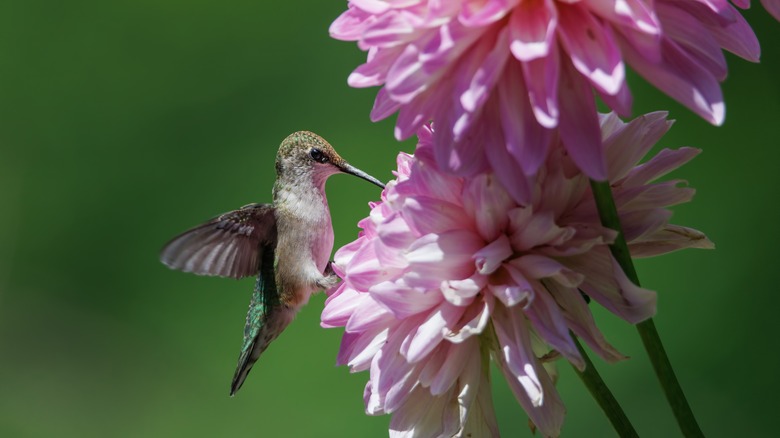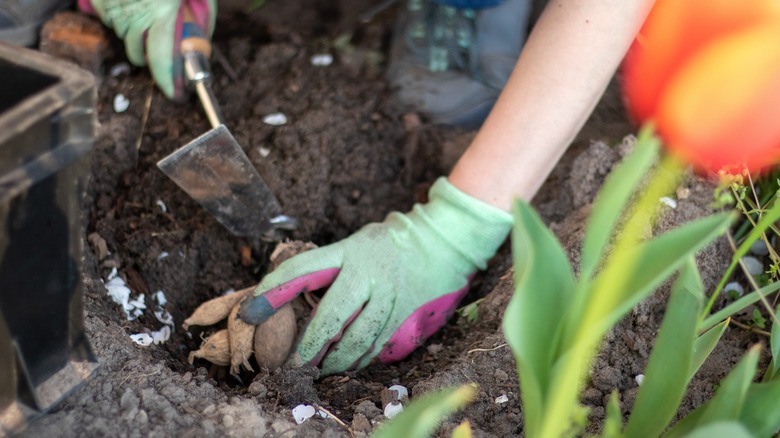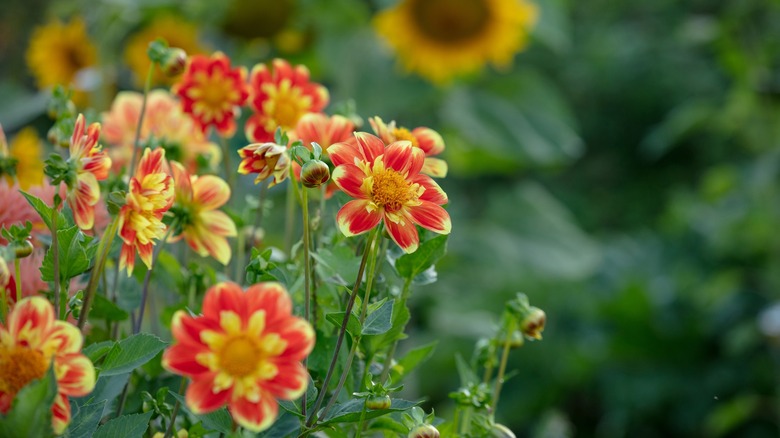Grow Dahlias To Attract Beautiful Hummingbirds (But Don't Make This Mistake)
Dahlias are gorgeous flowers that bring color and beauty to your garden, not only because they are stunning themselves, but also because they attract beautiful hummingbirds to your yard. Hummingbirds love dahlia nectar and flock to enjoy the flowers. Your dahlias will only be a good food source for hummingbirds if you choose the right varieties though, so don't make the mistake of opting for ones whose petals are so closely compacted that pollinators can't access the nectar.
Native to Mexico and Central America, dahlias come in a truly staggering range of shapes and sizes, from massive dinner plate dahlias like the iconic cafe au lait with its 10-inch flowers to tiny pompon dahlias like Frank Holmes, which feature ball-shaped 2-inch blooms. While there is a wide range of options for dahlias, the best ones for attracting hummingbirds and other pollinators are open-faced dahlias where the nectaries are accessible. Unlike ball and waterlily dahlias, where nectaries are covered with petals, preventing easy access for hungry hummers, single, orchid, collarette, and other similarly open dahlias make it easy for hummingbirds to access the nutrition they need.
Growing dahlias from seeds versus tubers
Dahlias can be purchased either from seed or as tubers. While tubers are more expensive, you can be assured that you will be getting the exact type of hummingbird-friendly dahlia you want. Dahlias grown from seeds, however, have a lot more variability in shape and color thanks to their complex genetic makeup. But because most dahlias grown from seed tend to be open-faced, they're still a great option for pollinator gardens.
If you are growing dahlias from seed, it's best to start them indoors around two months before your last frost and transplant your seedlings outside after the weather has warmed. Dahlia tubers can be planted out a week or two before the last frost. Regardless of whether your dahlias start from seeds or tubers, the best place to plant dahlias for stunning blooms is in full sun. Additionally, provide them with plenty of well-drained soil that's high in organic material. Dahlias are quite heavy feeders, so once a month, applications of a low-nitrogen fertilizer are also helpful for ensuring they thrive.
While dahlia tubers can survive winters outside in zones 7 and up, in colder zones you need to dig up and store your tubers if you would like to grow them again the following year. Even dahlias started from seed can have tubers by the end of summer. You can also save your dahlia seeds and grow a new generation of plants the next year.
Using dahlias in a pollinator garden
In addition to choosing open-face dahlia varieties, you may also want to use primarily red dahlias if your goal is to attract hummingbirds to your garden, as it is a color they are very much attracted to. Don't forget to provide the hummingbirds with water and perches nearby too, so they have everything they need. Additionally, try to avoid using pesticides as much as possible, both because they could directly hurt the hummingbirds and because many of the small insects these sprays kill are important parts of their diet. You may even find that once hummingbirds have moved into your yard, they largely handle pest management for you.
Because dahlias come in so many different sizes and shapes, you can easily create a vibrant hummingbird or pollinator garden using only dahlias. Just make sure to plant taller dahlias like HS date, which can grow to 3 feet, toward the back of your garden, and put more petite varieties like dahlegria tri-colore, which stays around 18 inches, closer to the front. Alternatively, you can also incorporate other flowers hummingbirds absolutely love, like salvias and columbines into your garden, giving the birds a wide range of options.


